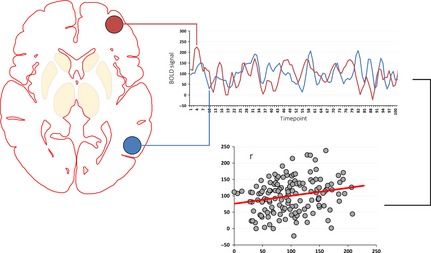Figure 1.

Seed‐based correlation techniques are straightforward and easily interpretable methods in functional connectivity analysis 96 that necessitate a priori hypotheses for seed definition. Briefly, the mean time courses of regions of interest (ROI)—representing structures or circuits of interest, or the main nodes of ICNs—are extracted. In seed‐to‐seed (or node‐to‐node) techniques, the mean time course of each ROI is correlated with the mean time courses of every other ROI, limiting the analysis to the circuits of interest. Alternatively, in seed‐to‐whole‐brain analyses, ROI time courses are used as regressors against the time courses of all voxels in the brain. Whole‐brain r‐correlation maps—in which the value assigned to each voxel is given by the correlation coefficient between its time series and the time series of the ROI in question—are thus generated, corresponding to the functional connectivity maps of each ROI. Subsequently, Fisher's r‐to‐z transformation is typically applied to ensure that the correlation coefficients are approximately normally distributed. The resulting connectivity maps are then analyzed using voxelwise statistical testing.
